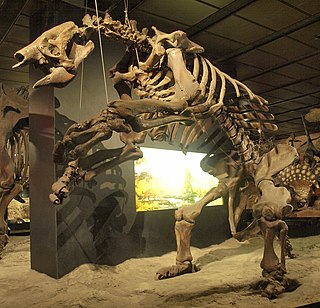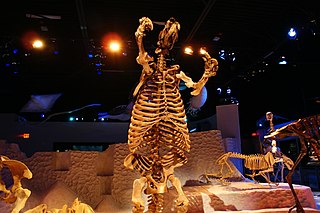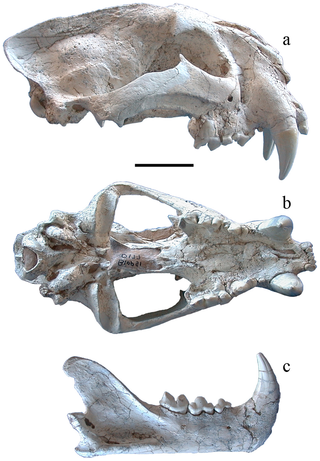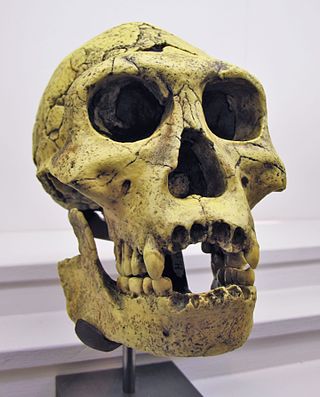
Chipmunks are small, striped rodents of Sciuridae, the squirrel family; specifically, they are ground squirrels (Marmotini). Chipmunks are found in North America, with the exception of the Siberian chipmunk which is found primarily in Asia.

The order Peramelemorphia includes the bandicoots and bilbies. All members of the order are endemic to Australia-New Guinea and most have the characteristic bandicoot shape: a plump, arch-backed body with a long, delicately tapering snout, very large upright ears, relatively long, thin legs, and a thin tail. Their size varies from about 140 grams up to 4 kilograms, but most species are about one kilogram.

Ground squirrels are rodents of the squirrel family (Sciuridae) that generally live on the ground or in burrows, rather than in trees like the tree squirrels. The term is most often used for the medium-sized ground squirrels, as the larger ones are more commonly known as marmots or prairie dogs, while the smaller and less bushy-tailed ground squirrels tend to be known as chipmunks.

Dmanisi is a town and archaeological site in the Kvemo Kartli region of Georgia approximately 93 km southwest of the nation’s capital Tbilisi in the river valley of Mashavera. The hominin site is dated to 1.8 million years ago. It was the earliest known evidence of hominins outside Africa before stone tools dated to 2.1 million years were discovered in 2018 in Shangchen, China.

The eastern chipmunk is a chipmunk species found in eastern North America. It is the only living member of the genus Tamias.

Tamias is a genus of chipmunks in the tribe Marmotini of the squirrel family. The genus includes a single living species, the eastern chipmunk. The genus name Tamias means "treasurer", "steward", or "housekeeper", which is a reference to the animals' role in plant dispersal through their habit of collecting and storing food for winter use.

Palaeoloxodon recki, often known by the synonym Elephas recki is an extinct species of elephant native to Africa and West Asia from the Pliocene or Early Pleistocene to the Middle Pleistocene. During most of its existence, the species represented the dominant elephant species in East Africa. The species is divided into five roughly chronologically successive subspecies. While the type and latest subspecies P. recki recki as well as the preceding P. recki ileretensis are widely accepted to be closely related to Eurasian Palaeoloxodon, the relationships of the other, chronologically earlier subspecies to P. recki recki and P. recki ileretensis are uncertain, with it being suggested they are unrelated and should be elevated to separate species.

Megantereon is an extinct genus of prehistoric machairodontine saber-toothed cat that lived in North America, Eurasia, and Africa. It is closely related to and possibly the ancestor of Smilodon.

Ancylotherium is an extinct genus of the family Chalicotheriidae, subfamily Schizotheriinae, endemic to Europe, Asia, and Africa during the Late Miocene-Early Pleistocene, existing for approximately 9.8 million years.

The Uinta chipmunk or hidden forest chipmunk, is a species of chipmunk in the family Sciuridae. It is endemic to the United States. Formerly known as Tamias umbrinus, phylogenetic studies have shown it to be sufficiently distinct from the eastern chipmunk as to be placed in a separate genus, Neotamias. The same studies have also suggested that Palmer's chipmunk may actually be a subspecies of Uinta chipmunk, although the two are still generally regarded as separate species.

Toyotamaphimeia is a genus of extinct gavialid crocodylian which lived in Japan and Taiwan during the Pleistocene. A specimen recovered in 1964 at Osaka University during the construction of a new science building has been dated to around 430–380 thousand years old based on the stratum in which it was found. Toyotamaphimeia was a fairly large crocodylian measuring approximately 6.3–7.3 metres (21–24 ft) long. Two species are named, T. machikanensis from Japan and T. taiwanicus from Taiwan, both originally described as members of the genus Tomistoma.

Eremotherium is an extinct genus of giant ground sloth in the family Megatheriidae. Eremotherium lived in southern North America, Central America, and northern South America from the Pliocene, around 5.3 million years ago, to the end of the Late Pleistocene, around 10,000 years ago. Eremotherium was one of the largest ground sloths, with a body size comparable to elephants, with estimated body mass of 3–6.55 tonnes (6,600–14,400 lb) and a body length of 6 metres (20 ft), being rivalled in size among ground sloths only by its close relative Megatherium. Eremotherium was widespread in tropical and subtropical lowlands and lived there in partly open and closed landscapes, while its close relative Megatherium lived in more temperate climes of South America. Characteristic of Eremotherium was its robust physique with comparatively long limbs and front and hind feet especially for later representatives- three fingers. However, the skull is relatively gracile, the teeth are uniform and high-crowned. Like today's sloths, Eremotherium was purely herbivorous and was probably a mixed feeder that dined on leaves and grasses. Eremotherium was a generalist that could adapt its diet to the respective local and climatic conditions of many regions. Finds of Eremotherium are common and widespread, with fossils being found as far north as South Carolina in the United States and as far south as Rio Grande Do Sul in Brazil, and many complete skeletons have been unearthed.

Pachystruthio is a genus of extinct bird which lived in Eurasia from the Late Pliocene to the Middle Pleistocene. Its fossils have been found in Hungary, Greece Crimea, Georgia, and China. The genus contains three species: P. pannonicus, P. dmanisensis, and P. transcaucasicus, which were all formerly placed with the ostrich genus, Struthio. An incomplete femur from the Nihewan Formation (China) has been assigned to Pachystruthio indet. P. dmanisensis has been estimated standing 3.5 meters tall and weighing up to 450 kg (990 lb), making it much larger than the modern ostrich and one of the largest known birds.

Canis lepophagus is an extinct species of canid which was endemic to much of North America during the Early Pliocene. It is notable because its lineage is proposed to have led to both wolves and coyotes.

Thinobadistes is an extinct genus of ground sloth of the family Mylodontidae endemic to North America during the Miocene-Pliocene epochs (Hemphillian). It lived from 10.3 to 4.9 mya, existing for approximately 5.4 million years.
Rimasuchus is an extinct genus of crocodile from the Miocene of Egypt and possibly Libya. Only one species - Rimasuchus lloydi - is currently known. It was previously thought to be a species of Crocodylus, but is now thought to be more closely related to the modern African dwarf crocodiles (Osteolaemus).

Panthera zdanskyi is an extinct pantherine species, the fossils of which were excavated in Gansu Province, northwestern China. Due to its close relationship with the modern tiger, it is called the Longdan tiger.

Paleontology in Georgia refers to paleontological research occurring within or conducted by people from the U.S. state of Georgia. During the early part of the Paleozoic, Georgia was largely covered by seawater. Although no major Paleozoic discoveries have been uncovered in Georgia, the local fossil record documents a great diversity of ancient life in the state. Inhabitants of Georgia's early Paleozoic sea included corals, stromatolites, and trilobites. During the Carboniferous local sea levels dropped and a vast complex of richly vegetated delta formed in the state. These swampy deltas were home to early tetrapods which left behind footprints that would later fossilize. Little is known of Triassic Georgia and the Jurassic is absent altogether from the state's rock record. During the Cretaceous, however, southern Georgia was covered by a sea that was home to invertebrates and fishes. On land, the tree Araucaria grew, and dinosaurs inhabited the state. Southern Georgia remained submerged by shallow seawater into the ensuing Paleogene and Neogene periods of the Cenozoic era. These seas were home to small coral reefs and a variety of other marine invertebrates. By the Pleistocene the state was mostly dry land covered in forests and grasslands home to mammoths and giant ground sloths. Local coal mining activity has a history of serendipitous Carboniferous-aged fossil discoveries. Another major event in Georgian paleontology was a 1963 discovery of Pleistocene fossils in Bartow County. Shark teeth are the Georgia state fossil.

The Dmanisi skull, also known as Skull 5 or D4500, is one of five skulls discovered in Dmanisi, Georgia and classified as early Homo erectus. Described in a publication in October 2013, it is estimated to be about 1.8 million years old and is the most complete skull of a Pleistocene Homo species, and the first complete adult hominin skull of that degree of antiquity. According to researchers, the discovery "provides the first evidence that early Homo comprised adult individuals with small brains but body mass, stature and limb proportions reaching the lower range limit of modern variation."

The Dmanisi hominins, Dmanisi people, or Dmanisi man were a population of Early Pleistocene hominins whose fossils have been recovered at Dmanisi, Georgia. The fossils and stone tools recovered at Dmanisi range in age from 1.85 to 1.77 million years old, making the Dmanisi hominins the earliest well-dated hominin fossils in Eurasia and the best preserved fossils of early Homo from a single site so early in time, though earlier fossils and artifacts have been found in Asia. Though their precise classification is controversial and disputed, the Dmanisi fossils are highly significant within research on early hominin migrations out of Africa. The Dmanisi hominins are known from over a hundred postcranial fossils and five famous well-preserved skulls, referred to as Dmanisi Skulls 1–5.
















